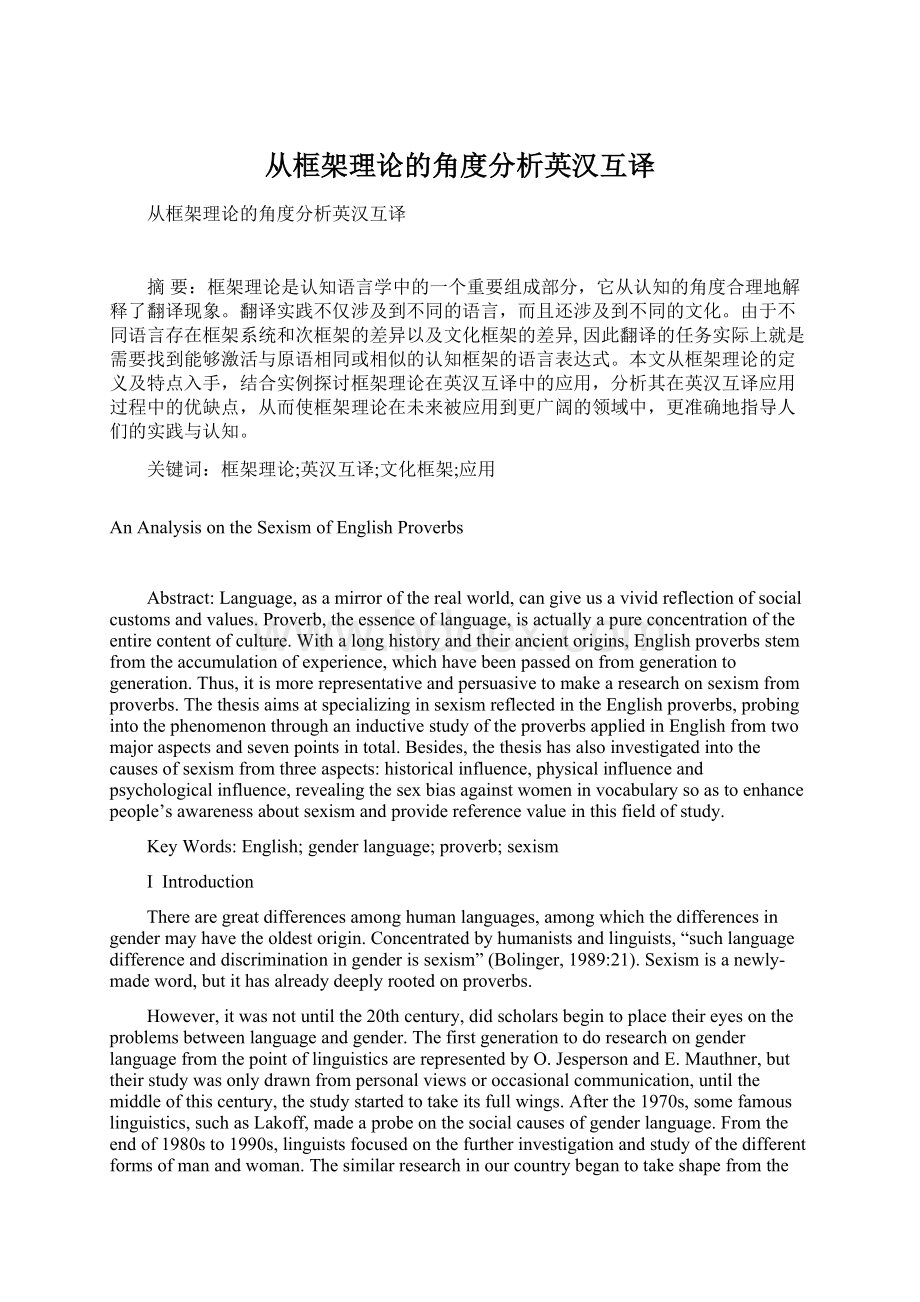 从框架理论的角度分析英汉互译.docx
从框架理论的角度分析英汉互译.docx
- 文档编号:8510732
- 上传时间:2023-01-31
- 格式:DOCX
- 页数:14
- 大小:29.83KB
从框架理论的角度分析英汉互译.docx
《从框架理论的角度分析英汉互译.docx》由会员分享,可在线阅读,更多相关《从框架理论的角度分析英汉互译.docx(14页珍藏版)》请在冰豆网上搜索。

从框架理论的角度分析英汉互译
从框架理论的角度分析英汉互译
摘要:
框架理论是认知语言学中的一个重要组成部分,它从认知的角度合理地解释了翻译现象。
翻译实践不仅涉及到不同的语言,而且还涉及到不同的文化。
由于不同语言存在框架系统和次框架的差异以及文化框架的差异,因此翻译的任务实际上就是需要找到能够激活与原语相同或相似的认知框架的语言表达式。
本文从框架理论的定义及特点入手,结合实例探讨框架理论在英汉互译中的应用,分析其在英汉互译应用过程中的优缺点,从而使框架理论在未来被应用到更广阔的领域中,更准确地指导人们的实践与认知。
关键词:
框架理论;英汉互译;文化框架;应用
AnAnalysisontheSexismofEnglishProverbs
Abstract:
Language,asamirroroftherealworld,cangiveusavividreflectionofsocialcustomsandvalues.Proverb,theessenceoflanguage,isactuallyapureconcentrationoftheentirecontentofculture.Withalonghistoryandtheirancientorigins,Englishproverbsstemfromtheaccumulationofexperience,whichhavebeenpassedonfromgenerationtogeneration.Thus,itismorerepresentativeandpersuasivetomakearesearchonsexismfromproverbs.ThethesisaimsatspecializinginsexismreflectedintheEnglishproverbs,probingintothephenomenonthroughaninductivestudyoftheproverbsappliedinEnglishfromtwomajoraspectsandsevenpointsintotal.Besides,thethesishasalsoinvestigatedintothecausesofsexismfromthreeaspects:
historicalinfluence,physicalinfluenceandpsychologicalinfluence,revealingthesexbiasagainstwomeninvocabularysoastoenhancepeople’sawarenessaboutsexismandprovidereferencevalueinthisfieldofstudy.
KeyWords:
English;genderlanguage;proverb;sexism
IIntroduction
Therearegreatdifferencesamonghumanlanguages,amongwhichthedifferencesingendermayhavetheoldestorigin.Concentratedbyhumanistsandlinguists,“suchlanguagedifferenceanddiscriminationingenderissexism”(Bolinger,1989:
21).Sexismisanewly-madeword,butithasalreadydeeplyrootedonproverbs.
However,itwasnotuntilthe20thcentury,didscholarsbegintoplacetheireyesontheproblemsbetweenlanguageandgender.ThefirstgenerationtodoresearchongenderlanguagefromthepointoflinguisticsarerepresentedbyO.JespersonandE.Mauthner,buttheirstudywasonlydrawnfrompersonalviewsoroccasionalcommunication,untilthemiddleofthiscentury,thestudystartedtotakeitsfullwings.Afterthe1970s,somefamouslinguistics,suchasLakoff,madeaprobeonthesocialcausesofgenderlanguage.Fromtheendof1980sto1990s,linguistsfocusedonthefurtherinvestigationandstudyofthedifferentformsofmanandwoman.Thesimilarresearchinourcountrybegantotakeshapefromtheendof1970s,andmostofthearticlesatthattimewerejusttheintroductionofgenderfromtheperspectiveofEnglishcultureorigin.Thecontrastiveanalysisandresearchoriginatedfromthe1980s,theexpertsinthisfieldwerenotmany,suchasSun’sGenderandLanguage(1997)whichmadeanelaboratestudyonthebasisofpsycholinguistics.Nowadays,moreandmorelinguistsputforwardmanysystematicandcomprehensivebooksandauthoritativearticles,suchasZhao’sLanguageandGender(2003).
Proverb,anindispensiblepartinthethesis,isactuallyapureconcentrationoftheentirecontentofculture,and“thewisdomofnationsliesintheirproverbs.”(ThomasPaine,1935:
201)Withalonghistoryandtheirancientorigin,Englishproverbsstemfromtheaccumulationofexperienceofdailylifeandthewisdomofthecommonpeople,whichhasbeenhandeddownfromgenerationtogeneration.Thusaproverbisamorerepresentativeandpersuasiveperspectivetomakearesearchonsexism.Bymeansofaninductivestudy,thethesishasprobedintothesexismphenomenonoftheproverbsappliedinEnglishfromthreemajoraspectsandsevenpointsintotal.Furthermore,thethesishasalsoinvestigatedintothecausesofsexismfromthreeaspects:
historicalinfluence,physicalinfluenceandpsychologicalinfluence,aimingatmakingacleardemonstrationofsexisminlanguagelevelandhopingtohelppeoplereducethedailybiasagainstwomen.
IIProverbsandSexism
Inthispart,someknowledgeofproverbandsexismwillbeexposed,amongwhichtheoriginanddevelopmentofproverbwillgiveusalittleillustrationabouttheexistenceofsexisminEnglish.
2.1Proverbs
Proverb,asthespecialformoflanguage,isoneofthetypesofidioms1,whichexistsinalllanguages.Althoughweareveryfamiliarwithproverbs,itishardtomakeacorrectdefinitionfortheterm“proverb”.Andmanyauthoritativedictionariesprovidevariousdefinitions.AccordingtoOxfordAdvancedLearner’sEnglish一ChineseDictionary,aproverbis“ashortwell-knownsayingthatstatesageneraltruthorgivesadvice”(2004:
1384).Anditisbelievedthataproverbtypicallyexpressesacommonthoughtinasuccinct,oftenmetaphoricalway.Succinctandpithysayingisingeneraluseandexpressescommonideasandbeliefs.
Proverbisapartofeveryspokenlanguageandfolkliterature,originatinginoraltradition.Oftenaproverbisfoundwithvariationsinmanydifferentpartsoftheworld.LiteratesocietiesdatingbacktotheancientEgyptianshavecollectedproverbs.Itisbelievedthattheword“proverb”firsttookitsshapefromtheGreekword“paroimia”,whichhasthemeaningoffiguration,referringtosuchkindsofwordsdifficulttobeunderstood,orwordstobeunderstoodaftersecondthought.AmajorityofproverbsarefromthemythofGreeceandRome,allegory,dramaandmanyfamousworks,whicharedifferentfromthoseforgedfromthedailylife.InEnglish,thewordproverbatfirstcoversfarmorecontentsthannow,whichconcludesidiom,metaphoraswellasmanyregularpetwords.Itissaidthat47%orsotookitsshapeinthe17thcentury.Inthe18thcentury,around16%appeared,while12%inthe19thcentury.Soitisquiteclearthatmostproverbscameintoexistencebeforethe17thcentury.InNorthAmerica,thebest-knowncollectionisprobablyPoorRichard'sAlmanac2.Proverbsarecreatedbycommonpeople,transmittedthroughdailycommunication,whicharethesummaryofgeneralregulatoryexperienceandthefruitsofthewisdomofthecommon.Accordingtotheircontents,theycanbedividedintofourmajorparts:
meteorologicalproverbs,archaeologicalproverbs,livingproverbsandsocialproverbs.Thefirstoneisfromthecourseofknowingthenatureandconcludingtheexperienceofdailylife,thesecondoneisbasedontheproducingexperienceoffarmingbypeasants,whilethethirdonetakesitsoriginfromthesummaryofhealthprotectionandhygiene,thelastkindisfromtheattentioninsocializing,dealingwiththingsbothhomeandbroad.
Asisshownabove,aproverbisakindofsayingwhichexpressesatruthbasedoncommonsenseortheagelesshumanexperienceofthepeopleinsimpleandconcrete,thoughoftenmetaphoricallanguage.Beinganessentialpartoflanguage,itplaysanimportantroleinlanguage,whichisconsideredaslivingfossilsbylinguistsbecausetheycontainalargequantityofagelesshumanexperience.Withoutproverbs,alanguagewouldbecomecolorlessandboringforlackingofvitalityandvividness.Therefore,itisnecessarytoundertakesomeresearchworkonproverbs.
2.2Sexism
Sexism,awordofprejudiceordiscriminationbasedonsex,especiallydiscriminationagainstwomenorbehavior,conditions,orattitudesthatfosterstereotypesofsocialrolesbasedonsex,firstcameknownin1968.SexismisananalogytermofracismmadebyAmericanfeminists,whichisdistinguisheditselfonthebasisofbiologicalsex.Sexism,moreoftenthannot,hastwodefinitions,onebeingthediscriminationofmentowardswomen,andviceversa.AccordingtoLongmanDictionaryofContemporaryEnglish,sexismisdefinedas“thebeliefthatwomenareweaker,lessintelligent,andlessimportantthanmen”(2007:
1807).So,itisnecessarytopointoutthatsexismwementionhereisthediscriminationofmentowardswomen.Thesexismreflectedinlanguagehasformedthesexismoflanguage.Itismadeupaftertherevelationoftheasymmetryinlanguage,whichhasabasisontheSapir-WhorfHypothesis.Andthehypothesispointsoutthatlanguagehascloserelationwithculture,forlanguageitselfisapartofculturewhosereflectionisinfactakindofculturalphenomena.Sapir-Whorfhypothesisputsmuchattentionontherelationbetweenlanguageandculture,whichgivesatheorybasistosexism.Forthisreason,thishypothesishasalternativelybeenreferredtoasLinguisticDeterminismandLinguisticRelativity3-aviewwhichwasfirstexpoundedbytheGermanethnologist.Linguisticsmaintainthelanguageunderthechainsofreligiouslawsandthesocialstatuescanreflectthenaturalcontentofsociety’sschemata—mentakethemajorrolesintheworldwhiletheimagesofwomenarebroken.
Inordertoacknowledgethetermsexismbetter,firstofall,wemustmakeadistinctionbetweensexandgender.Fromtheverybeginning,“gender”wasjustagrammaticallexiconwhichreferredtothefeminineormasculineofaword.Lateron,Westernfeministsadoptedandmadeitthekeyconceptoffeminism.OriginatedfromWesternfeminismmovements,feminismisthebeliefthatwomenshouldhaveequalrightstomenineveryaspect.Itinvolvesvariousmovements,theoriesandphilosophies,whichareallconcernedwiththeissuesofgenderdifferences.Feminismadvocatesequalityforwomenandalsocampaignsforwomen’srightsandinterests.Withtheextensivespreadingoffeminismsmovements,theconceptofgenderdevelopsandthenformsintoasystematicaltheory.Beforegendertheoryisdiscussed,abriefreviewofthosefeminismschoolsisnecessaryastheyhavecontributedalottoit.SimonedeBeauvoir,theauthorofTheSecondSex,oncesaid“sexisbiological,whilegenderissocialandcultural”(1973:
125).Inherbook,shearguedthatwomenthroughouthistoryhavebeendefinedasthe“other”sex,adeviationfromthe"normal"male.WhiletheBritishsociologistAnthony
- 配套讲稿:
如PPT文件的首页显示word图标,表示该PPT已包含配套word讲稿。双击word图标可打开word文档。
- 特殊限制:
部分文档作品中含有的国旗、国徽等图片,仅作为作品整体效果示例展示,禁止商用。设计者仅对作品中独创性部分享有著作权。
- 关 键 词:
- 框架 理论 角度 分析 英汉
 冰豆网所有资源均是用户自行上传分享,仅供网友学习交流,未经上传用户书面授权,请勿作他用。
冰豆网所有资源均是用户自行上传分享,仅供网友学习交流,未经上传用户书面授权,请勿作他用。


 铝散热器项目年度预算报告.docx
铝散热器项目年度预算报告.docx
